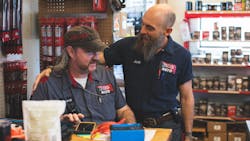The day that Erich Schmidt opened his own automotive repair business, he felt excited and confident.
The second day? Not so much.
Nearly 15 years later, Schmidt still remembers sitting alone at his desk in a 1,200-square foot, former 1950s-era service station, with no customers and nothing to do, wondering what the heck he’d gotten himself into.
“I started getting scared,” he says. “Definitely felt in over my head. I knew how to be a good technician, but there was so much I didn’t know about how to run a business.”
Juke Ball, owner of Juke Auto in Austin, Texas, had a similar experience after he rented two bays with no lifts at the side of a used car lot in 2004.
“We did well financially, but we weren’t organized,” Ball recalls. “It was inefficient and much more stressful than it needed to be. I was burning myself out.”
Schmidt and Ball have come a long way: Schmidt Auto Care now has a 12,000-square-foot shop in Springboro, Ohio. Six employees work alongside Schmidt and his wife, Lauralee, who joined the business full-time in 2016 and serves as vice president of operations. Ball’s 11,000-square-foot location, which he co-owns with his wife and CFO, Jonna, has 23 employees.
On their respective journeys, however, they have learned plenty of lessons—some of them quite painful.
Learning Business Basics
Schmidt and Ball have the same No. 1 tip for rookie owners: hire a coaching company, even if only for a short-term period.
“You have to go in with the mindset that you’re not doing this as a technician, but as a business owner,” Schmidt says. “It’s hard; I’m still a technician in my brain. You need people who keep you accountable in moving your business forward.”
Until Schmidt connected with Elite Worldwide and later The Institute for Automotive Business Excellence, he wasn’t taking the necessary steps to create a company with long-term value. He documented little, tracked few business indicators, and didn’t write up full vehicle inspection reports; instead, he simply fixed what the customer was concerned about and moved on.
Without standard service definitions, employee handbooks, or consistency in collecting information for a customer database, Schmidt Auto “would have been essentially worthless to anyone looking to acquire it,” Schmidt admits. “Everything was just willy-nilly.”
A set of detailed operating procedures has changed that. Take brakes, for example. If technicians measure brake pads at less than 4 millimeters, they advise replacement; 4 to 9 millimeters gets a yellow check mark, and 10 millimeters and above gets a green check. “Every technician follows the exact same system,” Schmidt reports.
Technicians also live by the 300% rule: inspect 100% of a vehicle, write up 100% of a vehicle, and present 100% of an estimate to customers even if they ultimately decline services. That process includes documenting issues with pictures and video to help people understand no one is trying to rip them off.
“It makes everything run smoother and builds better trust with the customer,” Schmidt notes. “It also guards against liability. If someone has metal-to-metal brakes and you have it well-documented that person was notified and knew it was unsafe, you’re protected.”
Ball’s initial mistake, meanwhile, was to try to do every job himself. He came into work early to pull vehicles out, ran and installed parts, answered customer calls, pitched in as a service advisor and even towed cars into the shop.
“I wanted to inspire people by busting my ass, but I was just making things harder for everyone,” he relates. “Leading by example through hard work is great, but an owner’s role is to create good structure. That’s what makes employees want to stay.”
A DRIVE coach helped Ball delegate responsibilities to supervisors on the floor and turn his attention to developing company policies. One such rule: anyone who spots a customer entering the parking lot or building should say hello and direct him or her to the right place.
“It can be intimidating to come into an auto shop,” Ball says. “If you have no idea where to go and people just walk by, it feels unintentionally hostile. That’s not what you want to project. It’s not just writing a policy, but explaining the ‘why’ of it. It’s not about being more ‘corporate’; it’s about treating people right and winding up with more work and sales because of it.”
Putting Together a Strong Team
Finding enough quality technicians and other team members isn’t easy. But tolerating negative employees is never the answer, veteran owners advise.
People who spend their days complaining—whether about their present job, past employers, or life in general—quickly drain energy and morale; those who are abusive to other team members are even worse. Ball has realized that as the owner, he is responsible for creating a healthy work environment where his staff can be happy and productive.
“If I could go back to that first year, I’d tell myself not to put up with it,” he says. “Why have those people in my building? They waste time and make everyone tense and just miserable. It’s bad for business. The quicker you can get rid of them, the better.”
Instead of fretting about not being able to locate a replacement, Ball suggests creating a shop where people want to work: one with fair pay and benefits, some flexibility on hours, supportive supervisors and teammates, good organization, clean and well-maintained facilities, quality tools and equipment, and reliable air conditioning and heat systems.
Juke Auto also throws in fun perks such as monthly barbecues, holiday parties and potlucks, and games with rewards for hitting certain business benchmarks. Most gatherings are held during the workday to avoid adding more hours to employees’ schedules.
The company uses social media to highlight employee and customer appreciation events for anyone who might be investigating its culture. “I’ve been surprised that a good number of people put money further down the list of what they’re looking for,” Ball says. “You don’t have to have the richest shop to have the best shop.”
Implementing a thorough new-hire vetting process is also crucial, Schmidt adds. When he first opened his doors, he brought on employees after they filled out a generic application form and did a short interview that often revolved mostly around salary discussions.
After several bad experiences with employees, Schmidt no longer considers applicants who haven’t compiled a resume, answered a few written questions, and done an initial phone interview with Lauralee, who digs into who they are as a person and their work habits. Only then do approved candidates talk to Erich about their technical skills.
“I need to know someone can administratively do simple tasks and be a positive teammate,” he explains. “Doing your best to feel out if someone would be a good fit in your work environment is still probably the hardest part of the business for me. It takes effort.”
Know Your Value
As many industry coaches will report, first-year owners tend to undercharge for parts and labor. Many of them also spend too much time thinking and worrying about competing shops in their area.
“I do remember looking around and setting my prices cheaper than everybody else, even if it was just by $2 or something,” Schmidt says. “I wasn’t focusing on myself and what my own shop needed to do its best. I may be the most expensive shop in town now, but good results are worth paying for.”
Higher net profits also will translate into better pay for skilled technicians and service advisors—which should reduce staff turnover—and allow for investments in upgraded facilities and tools that employees want.
“You can’t provide the latest equipment for modern cars if you’re not charging appropriately,” Schmidt says. “You’ve always got to be thinking about improving your business, not just landing individual jobs.”
Ball also warns against taking just any job, although new business owners are understandably concerned about building up a customer base as quickly as possible. His policy is to work only on vehicles made in 2000 or later, with some longer-term customers grandfathered in.
“Whatever you work on, that’s the sort of customer you will attract,” he notes. “If you take on old cars with owners without money to fix them, you’re generally going to get more of those. And no insult intended, but it’s tough to make a living on that.”
Ultimately, of course, time plus some inevitable trial-and-error moments are the best business mentors of all. Schmidt and Ball say they’re continuously learning in their roles, despite more than three decades of combined experience.
Yet as the two owners look ahead to the future, they also suggest that business leaders reflect regularly on what it was like to be a technician, service manager, or other automotive employee as they make decisions.
“Basically, I have tried to build the shop that I would have wanted myself as a technician,” Schmidt says. “I think that’s a way individual owners can be part of elevating our entire industry.”


